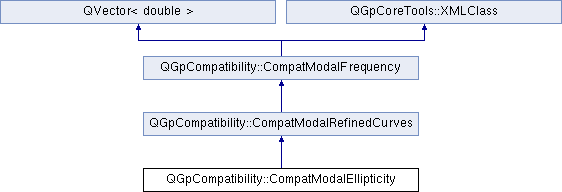
Calculate Rayleigh ellipticity curves and their misfits. More...
#include <CompatModalEllipticity.h>

Public Member Functions | |
| CompatModalEllipticity () | |
| CompatVDataPoint & | f0 () |
| double | frequencyMisfit (CompatModalDispersion &disp, Rayleigh &model) |
| double | misfit () |
| double | misfit (int iMin, int iMax) |
| CompatEllipticityData * | oldStyle () |
| void | operator= (CompatModalEllipticity &o) |
| bool | peakFrequencyMisfit () |
| virtual void | setNModes (int nm) |
| void | setPeakFrequencyMisfit (bool pfm) |
Protected Member Functions | |
| virtual XMLMember | xml_member (XML_MEMBER_ARGS) |
| bool | xml_setProperty (XML_SETPROPERTY_ARGS) |
| virtual const QString & | xml_tagName () const |
| virtual void | xml_writeChildren (XML_WRITECHILDREN_ARGS) const |
| virtual void | xml_writeProperties (XML_WRITEPROPERTIES_ARGS) const |
Static Protected Attributes | |
| static const QString | xmlModalEllipticityTag = "ModalEllipticity" |
Calculate Rayleigh ellipticity curves and their misfits.
The main function used to calculate the ellipticity curve is calculate().
Misfits can be computed by misfit() or closestModeMisfit().
| CompatVDataPoint& QGpCompatibility::CompatModalEllipticity::f0 | ( | ) | [inline] |
{return _f0;}
| double QGpCompatibility::CompatModalEllipticity::frequencyMisfit | ( | CompatModalDispersion & | disp, |
| Rayleigh & | model | ||
| ) |
| double QGpCompatibility::CompatModalEllipticity::misfit | ( | ) | [inline] |
| double QGpCompatibility::CompatModalEllipticity::misfit | ( | int | iMin, |
| int | iMax | ||
| ) |
Calculate the misfit for the current calculated ellipticity curve between frequency indexes iMin and iMax.
References COMPATMODALELLIPTICITY_INVALID_VALUE, QGpCoreTools::endl(), QGpCompatibility::CompatModalRefinedCurves::mode(), QGpCoreTools::sqrt(), QGpCoreTools::tr(), and TRACE.
{
TRACE;
// Global RMS is the sum of the RMS of all modes
double rms_val=0;
int omegaCountReal=iMax-iMin+1;
int omegaCountData=omegaCountReal;
CompatVDataPointVector point=mode(0);
for(int i=iMin;i<=iMax;i++)
rms_val+=point[i].misfitOrder2(omegaCountData, omegaCountReal, COMPATMODALELLIPTICITY_INVALID_VALUE);
if(omegaCountReal>0)
rms_val=sqrt(rms_val/omegaCountReal)*(1+omegaCountData-omegaCountReal);
else if(omegaCountData==0) rms_val=0;
else {
App::stream() << tr(" *** ERROR *** : no common value between calculated and data, this should never happen!") << endl;
rms_val=10000;
}
return rms_val;
}
References QGpCompatibility::CompatModalRefinedCurves::mode(), QGpCompatibility::CompatModalRefinedCurves::nModes(), QGpCompatibility::CompatModalFrequency::nOmegas(), QGpCompatibility::CompatModalFrequency::omega(), QGpCompatibility::CompatMultiModalFrequency::setFrequency(), QGpCompatibility::CompatMultiModalData::setMean(), QGpCompatibility::CompatMultiModalData::setStddev(), QGpCompatibility::CompatMultiModalCurves::setValue(), QGpCompatibility::CompatMultiModalData::setWeight(), and TRACE.
{
TRACE;
int nm=nModes();
int nf=nOmegas();
CompatEllipticityData * ell=new CompatEllipticityData(nm,nf);
for(int i=0;i<nf;i++) {
ell->setFrequency(i,omega(i)/(2*M_PI));
}
for(int im=0;im<nm;im++) {
CompatVDataPointVector point=mode(im);
for(int i=0;i<nf;i++) {
ell->setMean(i,im,point[i].mean());
ell->setStddev(i,im,point[i].stddev());
ell->setWeight(i,im,point[i].weight());
ell->setValue(i,im,point[i].value());
}
}
return ell;
}
| void QGpCompatibility::CompatModalEllipticity::operator= | ( | CompatModalEllipticity & | o | ) |
References TRACE.
{
TRACE;
CompatModalRefinedCurves::operator=(o);
_peakFrequencyMisfit=o._peakFrequencyMisfit;
_f0=o._f0;
}
| bool QGpCompatibility::CompatModalEllipticity::peakFrequencyMisfit | ( | ) | [inline] |
{return _peakFrequencyMisfit;}
| virtual void QGpCompatibility::CompatModalEllipticity::setNModes | ( | int | nm | ) | [inline, virtual] |
Reimplemented from QGpCompatibility::CompatModalRefinedCurves.
References QGpCompatibility::CompatModalRefinedCurves::setNModes().
{
CompatModalRefinedCurves::setNModes(nm);
setNRayleighModes(nm);
}
| void QGpCompatibility::CompatModalEllipticity::setPeakFrequencyMisfit | ( | bool | pfm | ) | [inline] |
{_peakFrequencyMisfit=pfm;}
| XMLMember QGpCompatibility::CompatModalEllipticity::xml_member | ( | XML_MEMBER_ARGS | ) | [protected, virtual] |
Re-implement this function to offer XML restore (children and properties) support to your class.
From tag and map (with contains the attibute value) return a unique identifier under the format of a XMLMember. XMLMember is initialized with 3 types of contructors:
Map of attributes can be inspected in this way (can be achived also in xml_setProperty()):
static const QString tmp("childrenName"); XMLRestoreAttributeIterator it=map.find(tmp); if(it!=map.end()) { // found attribute "childrenName" }
If the map of attributes is not used:
Q_UNUSED(attributes);
if(tag=="x1") return XMLMember(0);
else if(tag=="y1") return XMLMember(1);
else if(tag=="x2") return XMLMember(2);
else if(tag=="y2") return XMLMember(3);
else return XMLMember(XMLMember::Unknown);
Arithmetic operations + and - apply to XMLMember to avoid confusion of property id numbers between inherited objects. Offset 3 corresponds to the number of properties defined in this object.
if(tag=="anInteger") return XMLMember(0); else if(tag=="aString") return XMLMember(1); else if(tag=="aDouble") return XMLMember(2); return AbstractLine::xml_member(tag, attributes, context)+3;
For the arguments of this function use Macro XML_MEMBER_ARGS.
Reimplemented from QGpCompatibility::CompatModalRefinedCurves.
References TRACE.
{
TRACE;
if(tag=="DataPoint") return XMLMember(&_f0);
else if(tag=="peakFrequencyMisfit") return XMLMember(0);
return CompatModalRefinedCurves::xml_member(tag, attributes, context)+1;
}
| bool QGpCompatibility::CompatModalEllipticity::xml_setProperty | ( | XML_SETPROPERTY_ARGS | ) | [protected, virtual] |
Re-implement this function to offer XML restore properties support to your class.
From memberID set the corresponding property with value content. The map of attributes is given as a supplementary information (not useful in all cases).
For a general case:
Q_UNUSED(attributes); double val=content.toDouble(); switch (memberID) { case 0: _x1=val; return true; case 1: _y1=val; return true; case 2: _x2=val; return true; case 3: _y2=val; return true; default: return false; }
For classes inheriting other classes (see also xml_member())
switch (memberID) { case 0: _anInteger=content.toString(); return true; case 1: _aString=content.toInt(); return true; case 2: _aDouble=content.toDouble(); return true; default: return AbstractLine::xml_setProperty(memberID-3, map, content);
For the arguments of this function use Macro XML_SETPROPERTY_ARGS.
Reimplemented from QGpCompatibility::CompatModalFrequency.
References TRACE.
{
TRACE;
if(memberID==0) {
_peakFrequencyMisfit=content.toBool();
return true;
} else return CompatModalRefinedCurves::xml_setProperty(memberID-1, tag, attributes, content, context);
}
| virtual const QString& QGpCompatibility::CompatModalEllipticity::xml_tagName | ( | ) | const [inline, protected, virtual] |
Reimplemented from QGpCompatibility::CompatModalRefinedCurves.
{return xmlModalEllipticityTag;}
| void QGpCompatibility::CompatModalEllipticity::xml_writeChildren | ( | XML_WRITECHILDREN_ARGS | ) | const [protected, virtual] |
Reimplemented from QGpCompatibility::CompatModalRefinedCurves.
References TRACE, and QGpCoreTools::XMLClass::xml_save().
{
TRACE;
_f0.xml_save(s, context);
CompatModalRefinedCurves::xml_writeChildren(s, context);
}
| void QGpCompatibility::CompatModalEllipticity::xml_writeProperties | ( | XML_WRITEPROPERTIES_ARGS | ) | const [protected, virtual] |
Reimplemented from QGpCompatibility::CompatModalFrequency.
References TRACE, and QGpCoreTools::XMLClass::writeProperty().
{
TRACE;
writeProperty(s, "peakFrequencyMisfit",_peakFrequencyMisfit);
CompatModalRefinedCurves::xml_writeProperties(s, context);
}
const QString QGpCompatibility::CompatModalEllipticity::xmlModalEllipticityTag = "ModalEllipticity" [static, protected] |